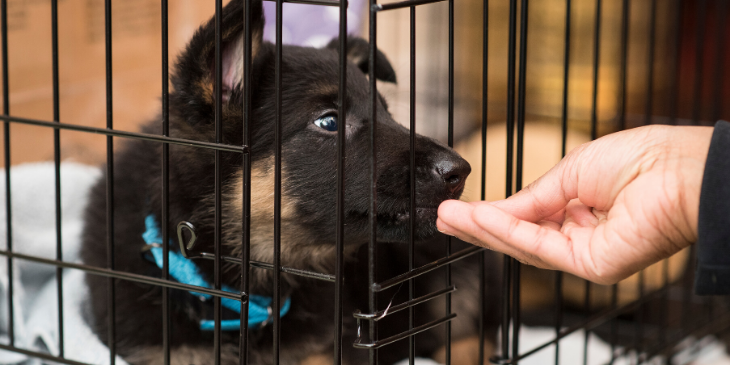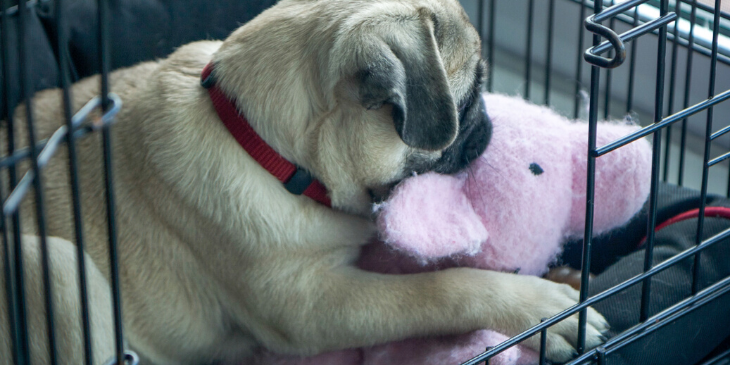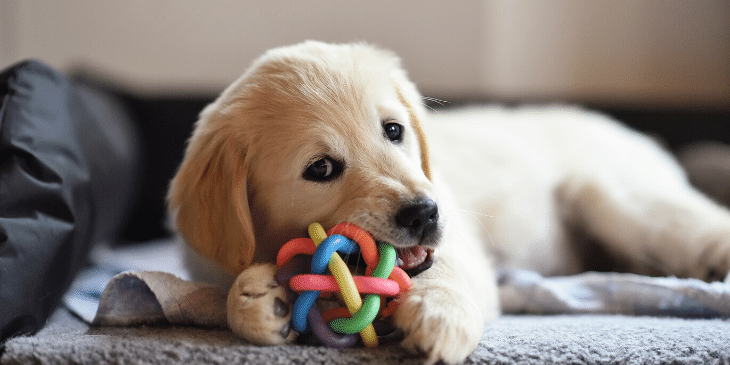Help! My Puppy Hates the Crate!

Contents
Crate training a puppy can be challenging, especially if your puppy hates the crate! They can be so dramatic with their barks, screams, and whines, leaving pet parents feeling guilty and wondering if it’s really worth all the drama.
On the other hand, nobody wants their dog peeing on the carpet either, and crate training is one of the best ways to housebreak a new puppy (or even an adult dog).
If this sounds like your situation, don’t worry, you’re not alone! We are here to help with several dog training tips to teach your puppy how to love his crate so you can use it without the guilt!
Why Crate Training is a Good Idea for Most Dogs
Most dog trainers and behaviorists recommend crate training puppies and adult dogs for a variety of reasons, and it’s easy to see why. First, crating a new puppy when you can’t supervise him makes potty training much easier. It also keeps him safe from things like chewing on cords, eating things he shouldn’t, or tangling with the cat.
A kennel is also a safe place where your dog can go to rest and relax, much like a den. By nature, dogs love small, cozy spaces and most dogs actually grow to love their crates once they realize they’re not being punished.
If you plan to travel with your dog, he needs to learn how to be content while crated, whether it’s in the car, on a plane, or if you’re staying in a hotel. And finally, if your dog ever needs to stay at a boarding kennel or vet’s office, it will be much less stressful for him if he’s already used to being in a dog crate.

Help your puppy learn to love his crate by making it extra cozy.
But, Don’t Abuse the Crate
Never ever use your dog’s crate as punishment or for a time-out! You want him to love his crate, not hate it. It’s also important to consider how much time your dog spends in the crate. Is he in there all day while you’re at work, and then again all night while you sleep? That’s too much!
If your dog can’t be trusted to have the run of the house during the day, find a way for him to get out of the crate for some exercise in the middle of the day. If you can’t come home for a walk and some playtime in the middle of the day, maybe you can pay a neighbor or hire a pet sitter to do it.
And of course, make sure your puppy or adult dog gets a long walk every day, along with lots of attention in the mornings, evenings, and on the weekends when you are home. Loneliness, boredom, and over-crating can definitely cause your dog or puppy to hate his crate, so don’t abuse it!
Special Considerations for Dogs with Anxiety Issues
If your dog has separation anxiety or gets very scared during storms, crate training may not be your best option. Putting a dog with anxiety issues in a crate could lead to injuries like broken teeth or toenails if he tries to escape the crate. Confining a panicked dog in a crate will make his anxiety issues even worse.
Fearful dogs with anxiety issues may do better if you use a baby gate to partition him off in a dog-safe room. Exercise pens are another great option. Some may even do fine confined to the laundry room, a bathroom, or even a spare bedroom while you’re out of the home. If all else fails, consider taking him to doggy daycare when you need to be out of the house for long periods of time.
That’s not to say that dogs with anxiety issues can never be crated if you really need to. But crate training a dog with existing anxiety issues does require starting over from the beginning with a lot of patience. And they should never be left locked up in their crate without supervision until you’re 100% sure they’re completely comfortable with it.
Why Your Puppy Hates the Crate
The first step to crate training a puppy or adult dog who already hates the crate is understanding why he hates it in the first place.
- Do you only crate him when you’re leaving? If so, he is probably associating the crate with being separated from his human. He needs to start thinking of the crate as his safe place, so start using it for short periods when you’re at home, such as while you’re in the shower or going to the mailbox. Toss some of his favorite toys and treats in there to keep him occupied and be sure to let him out before he starts whining to be freed.
- Do you let him out when he whines or barks? Obviously, if you let him out of the crate when he raises a fuss, he’s going to catch on to that pretty quickly. While we don’t recommend simply letting him cry it out, you are going to need to take steps to recondition this behavior. Try tiring him out with a long walk or some hard-core playtime before you put him in the crate. This way, he may fuss for a minute or two before and then just lay down for a nap. Try short spurts as recommended above, too, and be sure to let him out when he’s quiet, not when he’s whining.
- Did you simply start putting him in there without teaching him to love it? This is one of the biggest mistakes pet parents make! Your puppy needs to learn that good things happen in his crate. Give him a great big, magnificent treat when he’s in there and feed him his meals in his crate. Think about it. If you knew you were going to get a fantastic reward for going in the crate, wouldn’t you be a lot happier about it?
- Has he actually been crate trained? Whether you have a new puppy, an old puppy, or an adult dog, crate training requires you to teach him what you want him to do. If you only lock him in his crate when you leave and then let him out the moment you come home, he will quickly learn to hate his crate. Proper crate training requires you to be home and be an active part of the process, as defined below.
Keep in mind that animal shelters don’t always know a dog’s history. A dog who’s just been adopted may hate the crate for any of the above-mentioned reasons, from over-crating to separation anxiety, and there’s no way to know if he’s even been crate trained at all. No matter what age he is, you may have to start crate training from the very beginning, just like you would with a brand new puppy.

Use chew toys and treat puzzles to keep your puppy occupied while he gets used to his crate.
Crate Training a Dog or Puppy the Right Way
If possible, set your new puppy or adult dog up for success by planning ahead. Don’t introduce him to his crate right before you head out the door for work on Monday morning. Instead, begin the crate training process on a Friday evening when you’ll have the weekend to work with him.
1. Start with the right crate.
Whether you choose a wire crate or a plastic crate, the size is key. It should be just big enough for him to stretch out, stand up, and turn around in comfortably. Add a comfy dog bed, some chew toys, and a cozy cover to make it feel more den-like.
2. Choose the right location.
When you’re first starting out with crate training, choosing the right location for his crate is essential. Set it up where you hang out, such as next to the bed, in the living room by the couch, or in your office by your desk. Once he loves his crate, you can put it in a more remote area if you like.
3. Teach your dog to love his crate.
Don’t try to rush this process. Leave the crate door open and toss a treat inside. When he enters the crate to eat the treat, reward him with lots of praise and another treat while he’s still inside. Repeat this process often throughout the day.
You can also try putting a peanut butter filled Kong or treat-stuffed puzzle toy in the crate to get him to linger in the crate longer. Any time you catch him resting on that super comfy bed, offer a treat and some praise. Feed all meals in the crate, too.
4. Now, Try Closing the Crate Door
Once he starts going in the crate happily and you’ve caught him resting on the bed a few times, it’s time to start closing the door for short periods of time.
Start with a good long walk and some vigorous playtime to tire him out. Then toss an edible chew or a treat-dispensing toy in the crate. While he’s occupied, close the door. If he lays down for a nap, that’s great! If not, let him out before he starts to whine. Increase the time gradually for longer periods, using your dog as the guide.
5. Crate Training at Night
When you put your puppy in the crate at night, make sure he’s had a good long walk to tire him out. When he whines to go out, put him on his leash and take him out long enough to go to the bathroom. Don’t stimulate him with talking or petting… this is all about the business of peeing and going poop, then it’s right back to bed.
Remember that an old puppy or an adult dog can hold their bladder much longer than a young puppy. Young puppies will probably have you up to go potty several times in the middle of the night at first. House training a puppy requires patience on your part, but it will be worth it in the end.
The first night in a new home is often the hardest for puppies. Everything is unfamiliar to them and they’re separated from their mom and littermates for the first time. Animal behavior experts recommend locating the crate next to the bed or even sleeping on the floor next to it to help ease them through the transition.
Final Thoughts
Although crate training works for a lot of dogs, it isn’t for every dog. Most dogs can learn to love their crate using the techniques above, but others may hate being crated no matter what you do. For dogs like this, consider trying an alternative method, such as using a doggy gate, confining to a dog-safe room, or even putting a spacious chainlink kennel in your climate-controlled garage. At the end of the day, it’s all about finding what works best for you and your dog.
